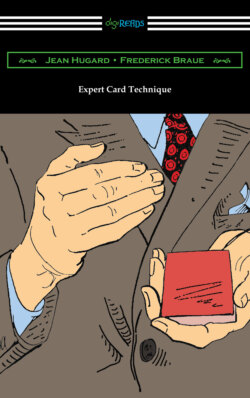Читать книгу Expert Card Technique - Jean Hugard - Страница 8
На сайте Литреса книга снята с продажи.
NOMENCLATURE
ОглавлениеThe following technical terms have been used in the text throughout this book. Most of them were originated by S. W. Erdnase to describe the procedures given in The Expert at the Card Table and have become a part of the conjurer’s lexicon.
Break: A minute division held in the pack to mark the position of a number of cards or of a single card. In conjuring the break is usually employed when the pack is held in the left hand as for dealing. The flesh at the outermost phalange of the little finger is pressed against the division at the right side at the inner corner (the finger tip is not inserted between the packets) and the remaining fingers are held together at the same side, concealing the subterfuge.
This break is often taken by the ball of the right thumb at the inner end of the pack, prior to an overhand shuffle, the fingers being at the outer end. The cards are shuffled into the left hand until those above the break have dropped; the remaining cards are then thrown upon those in the left hand. This is an easy method much used to bring a desired card to the top of the pack.
Bridge: To press the sides or ends of half the pack together so that the packet is made convex, if it be the upper half, or concave if it be the lower half. This is done to mark the position of a card or a number of cards. If a bridged pack is cut, this cut almost invariably will be at the bridge.
Crimp: To bend a part of a card, usually a corner, upward or downward, so that its position in the pack may be determined by sight. It is used to locate a single card or a stock which may be above or below the crimped card. It is possible to cut to such a card without glancing at the pack.
Cull: To secure certain cards at the top or bottom in the act of mixing the cards with the overhand shuffle.
Jog: A card extending for a fraction of an inch from any part of the pack. It marks the position of a desired card or of a stock of cards. When it is at the inner end of the pack the right hand in taking the pack for an overhand shuffle applies pressure with the ball of the thumb, turning the jog into a break, after which the cards are shuffled to this break and thrown, bringing the desired card or cards to the top.
A jog at the right side of the pack, when it is held by the left hand as for dealing, may be turned into a break by pulling down on the protruding edge with the tip of the left little finger, after which the pass may be made, or the card may be shuffled to the top.
Injog: A card protruding beyond the inner end of the pack. During an overhand shuffle a card is injogged by moving the right hand, with its packet, inwards towards the body. The left thumb draws off the top card of the right packet, thus causing it to protrude beyond the inner end. The remainder of the cards are then snuffled off.
Outjog: The same procedure, but the right hand moves outwards, causing the card to extend beyond the outer end. In the course of certain tricks, the outjog and injog may be employed during a single shuffle.
Joints and Phalanges: The joint or phalange nearest the palm is the first, or the innermost; the second is at the middle; the third is the outermost, that at the nail.
Run: During an overhand shuffle, to draw cards one at a time off the packet held by the right hand with the left thumb.
Stock: A number of cards, which may or may not be in an arranged sequence, which have been placed in some particular place in the pack, usually the top or bottom.
Shuffle Off: A genuine overhand shuffle, in which the cards are dropped from the right hand indiscriminately, in small packets.
Throw: During an overhand shuffle, to drop from the right hand packet onto the cards held by the left hand a number of cards in one packet, these cards retaining their order. Cards are usually thrown from above a break.
Undercut: To draw out a packet of cards from the bottom of the pack prior to an overhand shuffle.
